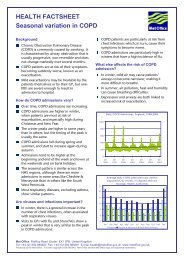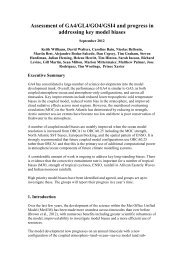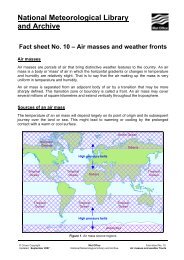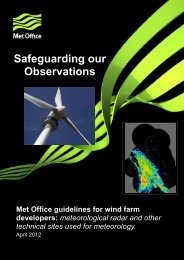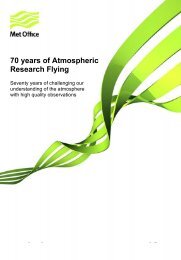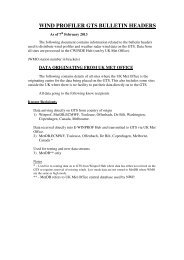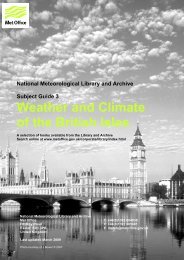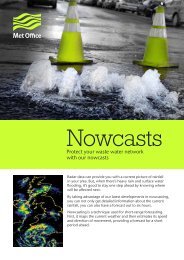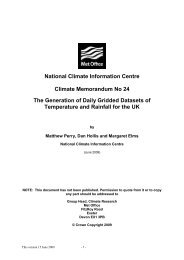Description and assessment of the OSTIA reanalysis. - Met Office
Description and assessment of the OSTIA reanalysis. - Met Office
Description and assessment of the OSTIA reanalysis. - Met Office
You also want an ePaper? Increase the reach of your titles
YUMPU automatically turns print PDFs into web optimized ePapers that Google loves.
The OSI-SAF processing flags provided with <strong>the</strong> dataset were not used in <strong>the</strong> <strong>OSTIA</strong> <strong>reanalysis</strong>,<br />
as although <strong>the</strong>y provide an indication <strong>of</strong> corrections applied or questionable data <strong>the</strong>y are not<br />
quality estimates nor are <strong>the</strong>y used to modify <strong>the</strong> ice concentration values <strong>the</strong>mselves. The 2 m<br />
air temperature check, indicating <strong>the</strong> possibility <strong>of</strong> false ice due to a surface air temperature above<br />
+10 o C was investigated but had a negligible impact on <strong>the</strong> <strong>OSTIA</strong> <strong>reanalysis</strong>. Ice concentration uncertainty<br />
estimates are not provided with <strong>the</strong> <strong>OSTIA</strong> <strong>reanalysis</strong> v1.0 data. OSI-SAF have provided<br />
an error estimate for <strong>the</strong> sea ice concentration data in <strong>the</strong> form <strong>of</strong> a st<strong>and</strong>ard deviation for each data<br />
point, derived from different error sources described in Eastwood et al. (2010), including representativeness,<br />
temporal sampling <strong>and</strong> r<strong>and</strong>om instrument noise. The OSI-SAF error estimates cannot<br />
be directly interpolated on to <strong>the</strong> <strong>OSTIA</strong> grid as <strong>the</strong> representativeness error is a function <strong>of</strong> grid<br />
size. However, it is planned to include an estimate <strong>of</strong> <strong>the</strong> ice concentration errors in future versions<br />
<strong>of</strong> <strong>the</strong> <strong>OSTIA</strong> <strong>reanalysis</strong>.<br />
A validation <strong>of</strong> <strong>the</strong> OSI-SAF ice concentration reprocessing dataset against weekly NIC (National<br />
Ice Center) ice charts was carried out by Tonboe <strong>and</strong> Nielsen (2010). The accuracy <strong>of</strong> <strong>the</strong><br />
OSI-SAF dataset based on this comparison was shown to be within 10-20% on a yearly average,<br />
although this figure has a strong seasonal dependence. The accuracy <strong>of</strong> sea ice concentration retrieval<br />
algorithms is known to be seasonally dependent (Robinson, 2004). For <strong>the</strong> best case, when<br />
<strong>the</strong>re are only one or two ice types present, <strong>the</strong> typical error <strong>of</strong> sea ice concentration retrieval algorithms<br />
is an underestimate <strong>of</strong> ice concentration <strong>of</strong> 4% (Robinson, 2004). The concentration may be<br />
underestimated by up to 30% in summer when meltponds are present, or in early autumn when it is<br />
difficult to distinguish young ice from open water (Robinson, 2004).<br />
During <strong>the</strong> brief overlap period between <strong>the</strong> SMMR <strong>and</strong> SSM/I instruments <strong>the</strong> data was compared<br />
by Tonboe <strong>and</strong> Nielsen (2010). The bias between <strong>the</strong> two instruments was found to be small<br />
(within a few percent) although SMMR estimates were higher along coastlines. Fur<strong>the</strong>r validation<br />
<strong>of</strong> <strong>the</strong> OSI-SAF/<strong>OSTIA</strong> sea ice concentration is included in <strong>the</strong> results section (section 4.4).<br />
© c Crown Copyright 2011 23




